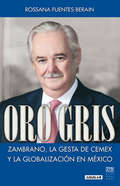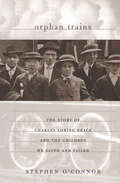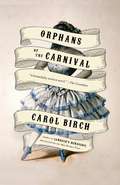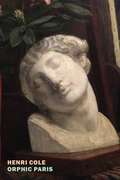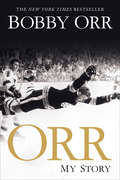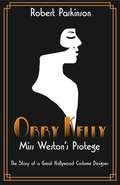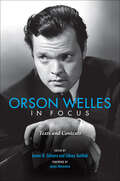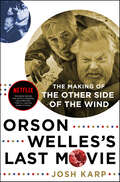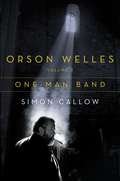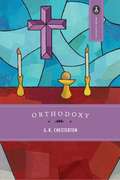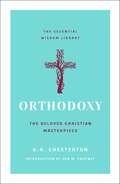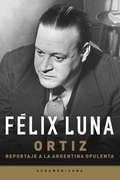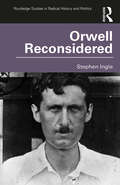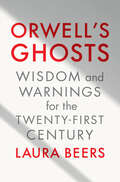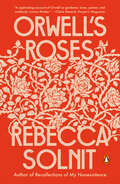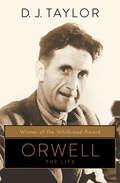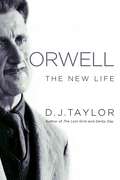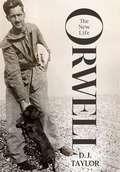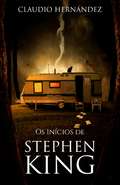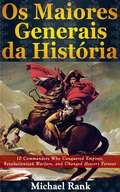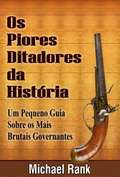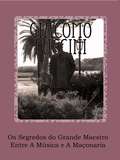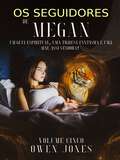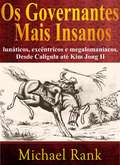- Table View
- List View
Oro gris: Zambrano, la gesta de CEMEX y la globalización en México
by Rossana Fuentes-BerainZambrano, la gesta de CEMEX y la globalización en México. Rossana Fuentes-Berain inició en 2005 una profunda investigación sobre una de las empresas más exitosas en la historia de nuestro país. Este libro penetra las entrañas de Cementos Mexicanos, CEMEX, y nos permite ahondar en la biografía de Lorenzo Zambrano, el empresario con una filosofía corporativa única que armado con gran creatividad e iniciativa se propuso hace 20 años llevar a su compañía a la cima, y lo logró. Transformó una compañía valuada en 300 millones de dólares, en una multinacional con presencia en más de 50 países, valuada en 25 mil millones de dólares. Este 12 de mayo Zambrano, a los 70 años, falleció en Madrid. Su legado es inspirador para la creciente ola de emprendedores en México y para los líderes empresariales a nivel mundial.
Orphan Trains: The Story of Charles Loring Brace and the Children He Saved and Failed
by Stephen O'ConnorThe true story behind Christina Baker Kline&’s bestselling novel is revealed in this &“engaging and thoughtful history&” of the Children&’s Aid Society (Los Angeles Times). A powerful blend of history, biography, and adventure, Orphan Trains fills a grievous gap in the American story. Tracing the evolution of the Children&’s Aid Society, this dramatic narrative tells the fascinating tale of one of the most famous—and sometimes infamous—child welfare programs: the orphan trains, which spirited away some two hundred fifty thousand abandoned children into the homes of rural families in the Midwest. In mid-nineteenth-century New York, vagrant children, whether orphans or runaways, filled the streets. The city&’s solution for years had been to sweep these children into prisons or almshouses. But a young minister named Charles Loring Brace took a different tack. With the creation of the Children&’s Aid Society in 1853, he provided homeless youngsters with shelter, education, and, for many, a new family out west. The family matching process was haphazard, to say the least: at town meetings, farming families took their pick of the orphan train riders. Some children, such as James Brady, who became governor of Alaska, found loving homes, while others, such as Charley Miller, who shot two boys on a train in Wyoming, saw no end to their misery. Complete with extraordinary photographs and deeply moving stories, Orphan Trains gives invaluable insights into a creative genius whose pioneering, if controversial, efforts inform child rescue work today.
Orphans of the Carnival: A Novel
by Carol BirchFrom the Booker short-listed author of Jamrach's Menagerie comes the extraordinary, moving, and unsettling tale of a woman, branded a freak from birth, who becomes an international sensation but longs for genuine human connection London had the best freaks, always had. The Egyptian Hall, the Promenade of Wonders, the Siamese twins, pinheads, midgets, cannibals, giants, living skeletons, the fat, the hairy, the legless, the armless, the noseless, London had seen it all. In the Hall of Ugliness the competition was stiff. But noone had ever seen anything quite like Julia . . .Pronounced by the most eminent physician of the day to be "a true hybrid wherein the nature of woman presides over that of the brute," Julia Pastrana stood apart from the other carnival acts. She was fluent in English, French and Spanish, an accomplished musician with an exquisite singing voice, equally at ease riding horseback and turning pirouettes--but all anyone noticed was her utterly unusual face. Alternately vilified and celebrated, Julia toured through New Orleans, New York, London, Berlin, Vienna, and Moscow, often hobknobbing with high society as she made her fame and fortune. Beneath the flashy lights and thunderous applause lies a bright, compassionate young woman who only wants people to see beyond her hairy visage--and perhaps, the chance for love. When Julia visits a mysterious shaman in the back alleys of New Orleans, he gives her a potion and says that she'll find a man within the year. Sure enough, Julia soon meets Theodore Lent, a boyishly charming showman who catapults Julia onto the global stage. As they travel the world, the two fall into an easy intimacy, but the question of whether Theo truly cares for Julia or if his management is just a gentler form of exploitation lingers heavily with every kind word and soft embrace. Stunningly written and deeply compelling, Orphans of the Carnival is a haunting examination of how we define ourselves and, ultimately, of what it means to be human.
Orpheus in the Marketplace
by Tim Carter Richard A. GoldthwaiteThe Florentine musician Jacopo Peri (1561-1633) is known as the composer of the first operas--they include the earliest to survive complete, Euridice (1600), in which Peri sang the role of Orpheus. The recent discovery of a large number of private account books belonging to him and his family allows for a greater exploration of Peri's professional and personal life. Richard Goldthwaite, an economic historian, and Tim Carter, a musicologist, have done more, however, than write a biography: their investigation exposes the value of such financial documents as a primary source for an entire period. This record of Peri's wide-ranging investments and activities in the marketplace enables the first detailed account of the Florentine economy in the late sixteenth and early seventeenth centuries, and opens a new perspective on one of Europe's principal centers of capitalism. His economic circumstances reflect continuities and transformations in Florentine society, and the strategies for negotiating them, under the Medici grand dukes. They also allow a reevaluation of Peri the singer and composer that elucidates the cultural life of a major artistic center even in changing times, providing a quite different view of what it meant to be a musician in late Renaissance Italy.
Orphic Paris
by Henri ColeA poetic portrait of Paris that combines prose poetry, diary, and memoir by award-winning writer and poet Henri Cole.Henri Cole’s Orphic Paris combines autobiography, diary, essay, and poetry with photographs to create a new form of elegiac memoir. With Paris as a backdrop, Cole, an award-winning American poet, explores with fresh and penetrating insight the nature of friendship and family, poetry and solitude, the self and freedom. Cole writes of Paris, “For a time, I lived here, where the call of life is so strong. My soul was colored by it. Instead of worshiping a creator or man, I cared fully for myself, and felt no guilt and confessed nothing, and in this place I wrote, I was nourished, and I grew.” Written under the tutelary spirit of Orpheus—mystic, oracular, entrancing—Orphic Paris is an intimate Paris journal and a literary commonplace book that is a touching, original, brilliant account of the city and of the artists, writers, and luminaries, including Cole himself, who have been moved by it to create.
Orr: My Story
by Bobby OrrThe NHL legend tells his story from his Ontario childhood to his years with the Bruins and Blackhawks, to today. New York Times Bestseller! Bobby Orr is often referred to as the greatest defenseman ever to play the game of hockey. <P><P>But all the brilliant achievements leave unsaid as much as they reveal. They don't tell what inspired Orr, what drove him, what it was like for a shy small-town kid to suddenly land in the full glare of the media. They don't tell what it was like when the agent he regarded as a brother betrayed him and left him in financial ruin. They don't tell what he thinks of the game of hockey today.Now he breaks his silence in a memoir as unique as the man himself...Includes photographsand I believe that I have lessons worth passing on." Orr: My Story is more than a book about hockey--it is about the making of a man.
Orry Kelly: Miss Weston's Protege
by Robert ParkinsonOrry Kelly, Miss Weston’s Protégé tells the incredible story of one of Hollywood’s greatest designers. Using never before seen materials, photographs and letters, Robert Parkinson has compiled years of research into one of the most detailed accounts of Orry Kelly’s history. Born in Kiama in December 1897 Orry Kelly moved to Sydney as a young man to seek a theatrical career and to study painting. Though unsuccessful on the stage he could not be dissuaded from his dream of stage fame. Eleanor Weston, a well-known Kiama businesswoman, encouraged Kelly to move to the US where he found his calling designing scenes and costume for film, television and the stage. Over the course of his career Orry Kelly worked for all of the major studios, including Warner Brothers, Paramount and Fox, dressing many of the well-known female stars in some 312 films. Though always widely renowned in Hollywood, Kelly did not gain his fame in Australia until after his death in 1964. As biographies of movie stars began to appear in the 1980s his fashion styling and costume design came to be highly regarded and worthy of study across several universities and colleges.
Orson Welles in Focus: Texts and Contexts
by James N. Gilmore and Sidney Gottlieb“A wonderful and distinct addition to the Welles canon . . . these pieces explore key elements of Welles’s career, personality, and political beliefs.” —Library JournalThrough his radio and film works, such as The War of the Worlds and Citizen Kane, Orson Welles became a household name in the United States. Yet Welles’s multifaceted career went beyond these classic titles and included lesser-known but nonetheless important contributions to television, theater, newspaper columns, and political activism. Orson Welles in Focus: Texts and Contexts examines neglected areas of Welles’s work, shedding light on aspects of his art that have been eclipsed by a narrow focus on his films. By positioning Welles’s work during a critical period of his activity (the mid-1930s through the 1950s) in its larger cultural, political, aesthetic, and industrial contexts, the contributors to this volume examine how he participated in and helped to shape modern media. This exploration of Welles in his totalityilluminates and expands our perception of his contributions that continue to resonate today.“Anyone who thinks they know Welles will have their eyes opened [by this book].” —Paul Heyer, author of The Medium and the Magician“This is a fascinating collection, several of the contributions making the reader wish for more.” —Film International“A team of scholars has examined the many facets of Orson Welles’ amazing life—theatrical innovator, radio star, celebrated filmmaker, newspaper columnist and progressive activist.” —Wellesnet
Orson Welles's Last Movie: The Making of The Other Side of the Wind
by Josh KarpJournalist Josh Karp shines a spotlight on the making of The Other Side of the Wind—the final unfinished film from the auteur of Citizen Kane in Orson Welles’s Last Movie, the basis of Oscar-winning director Morgan Neville’s Netflix Original Documentary, They’ll Love Me When I’m Dead.In the summer of 1970, legendary but self-destructive director Orson Welles returned to Hollywood from years of self-imposed exile in Europe and decided it was time to make a comeback movie. Coincidentally, it was the story of a legendary self-destructive director who returns to Hollywood from years of self-imposed exile in Europe. Welles swore it wasn’t autobiographical.The Other Side of the Wind was supposed to take place during a single day, and Welles planned to shoot it in eight weeks. It took six years during his lifetime—only to be finally completed more than thirty years after his death by The Last Picture Show director Peter Bogdanovich, who narrates the film, and released by Netflix. Orson Welles’s Last Movie is a fast-paced, behind-the-scenes account of the bizarre, hilarious, and remarkable making of what has been called “the greatest home movie that no one has ever seen.” Funded by the shah of Iran’s brother-in-law, and based on a script that Welles rewrote every night for years, the film was a final attempt to one-up his own best work. It’s a production best encompassed by its star—the celebrated director of The Maltese Falcon, John Huston—who described the making of the film as “an adventure shared by desperate men that finally came to nothing.”
Orson Welles, Volume 3: One-Man Band
by Simon CallowThe third volume of Simon Callow's acclaimed Orson Welles biography, covering the period of his exile from America (1947-1964), when he produced some of his greatest works, including Touch of EvilIn One-Man Band, the third volume in his epic and all-inclusive four-volume survey of Orson Welles's life and work, the celebrated British actor Simon Callow again probes in comprehensive and penetrating detail into one of the most complex, contradictory artists of the twentieth century, whose glorious triumphs (and occasional spectacular failures) in film, radio, theater, and television introduced a radical and original approach that opened up new directions in the arts. This volume begins with Welles's self-exile from America, and his realization that he could function only to his own satisfaction as an independent film maker, a one-man band, in fact, which committed him to a perpetual cycle of money raising. By 1964, he had filmed Othello, which took three years to complete; Mr. Arkadin, the most puzzling film in his output; and a masterpiece in another genre, Touch of Evil, which marked his one return to Hollywood, and like all too many of his films was wrested from his grasp and reedited. Along the way he made inroads into the fledgling medium of television and a number of stage plays, of which his 1955 London Moby-Dick is considered by theater historians to be one of the seminal productions of the century. His private life was as spectacularly complex and dramatic as his professional life. The book reveals what it was like to be around Welles, and, with an intricacy and precision rarely attempted before, what it was like to be him, answering the riddle that has long fascinated film scholars and lovers alike: Whatever happened to Orson Welles?
Orthodoxy: Large Print (Image Classics #12)
by G. K. ChestertonA Timeless Argument for Traditional ChristianityIf you think orthodoxy is boring and predictable, think again. In this timeless classic, G. K. Chesterton, one of the literary giants of the twentieth century, presents a logical and personal reasoning for Christianity in model apologetic form. Gilbert Keith Chesterton was a self-described pagan at age 12 and totally agnostic by age 16. Yet, his spiritual journey ultimately led to a personal philosophy of orthodox, biblical Christianity. The account of his experiences, Orthodoxy bridges the centuries and appeals to today's readers who face the same challenges of materialism, self-centeredness, and progress. "Hope means hoping when things are hopeless, or it is no virtue at all. And faith mean believing the incredible, or it is no virtue at all." --G.K. ChestertonA unique book, Orthodoxy addresses our faith struggles and how we communicate our faith to others. Through philosophy, poetry, reason and humor Chesterton leads us on a literary journey toward truth. This edition includes a foreword by Philip Yancey who, like C. S. Lewis and other leading Christian writers, found this book to be pivotal his Christian experience. Yancey credits Chesterton with helping to revive and define his faith.
Orthodoxy: The Beloved Christian Masterpiece (The Essential Wisdom Library)
by G. K. ChestertonA classic of Christian apologeticsPart spiritual autobiography, part apologetics, Orthodoxy is G.K. Chesterton's account of his own journey to faith. Chesterton didn’t set out to write a defense of Christian thought, instead he hoped to recount how he personally became a believer. However, in doing so, he penned one of the great classics of Christian writing, a book that has influenced countless people and continues to speak compellingly to our modern day. Chesterton writes about his journey of faith with wit, charm, and a razor-sharp intellect, undermining casual assumptions and lazy speculations in a relentless search for truth and meaning. Orthodoxy is the next title in the Essential Wisdom Library, a series of books that seeks to bring spiritual wisdom—both modern and ancient—to today’s readers. Featuring a foreword by Jon Sweeney, this new edition of the classic text is a must read for seekers and believers alike.
Ortiz: Reportaje a la Argentina opulenta
by Felix LunaFélix Luna reconstruye la trayectoria íntima y política del presidenteRoberto M. Ortiz, y el drama personal que afrontó cuando se hallabaempeñado en purificar el sistema electoral. El autor de «El 45» utiliza una original técnica expositiva paraaproximarse a la opulenta Argentina de los alrededores de 1940, quevivía una época de transformaciones sociales y económicas, como un oasispacífico en medio de la catástrofe de la Segunda Guerra Mundial. Estaobra constituye además un homenaje a la política del consenso encaradapor Ortiz para recuperar la dignidad de los comicios viciados por elfraude. La contraposición de la documentada crónica política con algunastípicas expresiones de la época -desde las modas hasta las crónicaspoliciales- permite al lector recuperar la atmósfera del país que siguióla lucha y el drama del presidente ciego.
Orwell Reconsidered (Routledge Studies in Radical History and Politics)
by Stephen IngleGeorge Orwell has had a profound influence on modern politics and culture. He is regularly invoked as an authority by journalists, commentators and politicians, and his works speak with increasing relevance to our polarised and media-saturated society. Stephen Ingle explores Orwell’s character, his life and his beliefs by guiding the reader through the main events, private and public, that shaped his life and major works. This includes his time fighting in the Spanish Civil War as well as the writing of classics like Animal Farm and 1984. The book also reconsiders Orwell’s legacy and contextualises his contemporary resonance. Orwell, it is argued, is more concerned with morality than ideology. This book will be of significant interest to students and other readers interested in Orwell’s life as well as his profound contribution to the history of social and political thought and English literature.
Orwell's Ghosts: Wisdom and Warnings for the Twenty-First Century
by Laura BeersFor the 75th anniversary of 1984, Laura Beers explores George Orwell’s still-radical ideas and why they are critical today. George Orwell dedicated his career to exposing social injustice and political duplicity, urging his readers to face hard truths about Western society and politics. Now, the uncanny parallels between the interwar era and our own—rising inequality, censorship, and challenges to traditional social hierarchies—make his writing even more of the moment. Invocations of Orwell and his classic dystopian novel 1984 have reached new heights, with both sides of the political spectrum embracing the rhetoric of Orwellianism. In Orwell’s Ghosts, historian Laura Beers considers Orwell’s full body of work—his six novels, three nonfiction works, and brilliant essays on politics, language, and the class system—to examine what “Orwellian” truly means and reveal the misconstrued thinker in all his complexity. She explores how Orwell’s writing on free speech addresses the proliferation of “fake news” and the emergence of cancel culture, highlights his vivid critiques of capitalism and the oppressive nature of the British Empire, and, in contrast, analyzes his failure to understand feminism. Timely, wide-ranging, and thought-provoking, Orwell’s Ghosts investigates how the writings of a lionized champion of truth and freedom can help us face the crises of modernity.
Orwell's Roses
by Rebecca Solnit&“An exhilarating romp through Orwell&’s life and times and also through the life and times of roses.&” —Margaret Atwood &“A captivating account of Orwell as gardener, lover, parent, and endlessly curious thinker.&” —Claire Messud, Harper's&“Nobody who reads it will ever think of Nineteen Eighty-Four in quite the same way.&”—Vogue A lush exploration of roses, pleasure, and politics, and a fresh take on George Orwell as an avid gardener whose political writing was grounded in his passion for the natural world&“In the year 1936 a writer planted roses.&” So begins Rebecca Solnit&’s new book, a reflection on George Orwell&’s passionate gardening and the way that his involvement with plants, particularly flowers, and the natural world illuminates his other commitments as a writer and antifascist, and the intertwined politics of nature and power. Sparked by her unexpected encounter with the surviving roses he planted in 1936, Solnit&’s account of this understudied aspect of Orwell&’s life explores his writing and his actions—from going deep into the coal mines of England, fighting in the Spanish Civil War, critiquing Stalin when much of the international left still supported him (and then critiquing that left), to his analysis of the relationship between lies and authoritarianism. Through Solnit&’s celebrated ability to draw unexpected connections, readers encounter the photographer Tina Modotti&’s roses and her Stalinism, Stalin&’s obsession with forcing lemons to grow in impossibly cold conditions, Orwell&’s slave-owning ancestors in Jamaica, Jamaica Kincaid&’s critique of colonialism and imperialism in the flower garden, and the brutal rose industry in Colombia that supplies the American market. The book draws to a close with a rereading of Nineteen Eighty-Four that completes her portrait of a more hopeful Orwell, as well as a reflection on pleasure, beauty, and joy as acts of resistance.
Orwell: The Life (Books About Bks.)
by D. J. TaylorWinner of the Whitbread Biography Award: the authoritative biography of one of the greatest authors of the twentieth century It was not easy to bury George Orwell. After a lifetime of iconoclasm, during which he professed no interest in religion and no affiliation with any church, he asked to be buried in an Anglican churchyard--but none would have him. Orwell's friends fought for him to have a proper grave, however, and the author of 1984, Animal Farm, and Homage to Catalonia, among other brilliant works of prose, poetry, and journalism, was laid to rest in a quiet country cemetery. Almost immediately, his legacy was in dispute. Orwell did not want any biographies written of him, but that has not stopped scholars from trying. Of all those published since the author's death in 1950, D. J. Taylor's prize-winning book is considered the most definitive. Born in India, Orwell spent his forty-six years of life traveling the British Empire and confronting the world head on. From the trenches of Spain to the top of bestseller lists, Taylor presents Orwell fully--as a writer, social critic, and human being.
Orwell: The New Life
by D. J. TaylorA fascinating exploration of George Orwell—and his body of work—by an award-winning Orwellian biographer and scholar, presenting the author anew to twenty-first-century readers. We find ourselves in an era when the moment is ripe for a reevaluation of the life and the works of one of the twentieth century&’s greatest authors. This is the first twenty-first-century biography on George Orwell, with special recognition to D. J. Taylor's stature as an award-winning biographer and Orwellian. Using new sources that are now available for the first time, we are tantalizingly at the end of the lifespan of Orwell's last few contemporaries, whose final reflections are caught in this book. The way we look at a writer and his canon has changed even over the course of the last two decades; there is a post-millennial prism through which we must now look for such a biography to be fresh and relevant. This is what Orwell: The New Life achieves.
Orwell: The New Life
by D.J. TaylorOver seventy years since his premature death, George Orwell (1903-50) has become one of the most significant figures in western literature. His two dystopian masterpieces, Animal Farm (1945) and Nineteen Eighty-Four (1949) have together sold over 40 million copies. Even now, he continues to exert a decisive influence on our understanding of international power-politics. D.J. Taylor's new biography, the first full-length study for 20 years, draws on a wide range of previously unseen material - newly-discovered letters to old girlfriends and professional colleagues, the recollections of the dwindling band of people who remember him, new information about his life in the early 1930s - to produce a definitive portrait of this complex, driven and self-mythologising man.
Os Inícios de Stephen King: Esta é a mais completa biografia sobre Stephen King
by Claudio HernándezO escritor de Maine, como muitos o chamam, estava predestinado a ser o melhor escritor de terror da história. Assim o demonstra em sua carreira literária. Apesar de ter que suportar centenas de recusas de seus primeiros contos e livro, o destino estava escrito: a prego que suportava as cartas de rejeição cairam finalmente no chão. Stephen King começou a escrever bem jovem aos oito anos de idade, e publicaria no início seus primeiros contos. Liam os meninos da sua escola. Não foi nada fácil chegar até a publicação de "Carrie", livro com o qual inicia seu lançamento profissional. Anteriormente substituia com muitos e variados trabalhos, e os cheques que cobrava por seus contos. A morte e o medo sempre estiveram a seu lado desde que cavava fossas no cemitério local na sua adolescência, com seu primeiro trabalho pago. Sua tenacidade e constância o fizeram ser reconhecido como o "Rei", tributo a seu sobrenome "King" que o caía bem. Aqui descobrirás seu início: desde sus tataravôs, avós, seus pais, a pobreza, a caixa de manuscritos de seu pai, seus primeiros contos, a época que não quer lembrar do instituto, a universidade, seus primeiros livros, seu trabalho como professor de língua inglesa, seu alter ego, seus problemas... e finalmente seu sucesso entra as massas. Este é um estudo de sua primeira etapa, a mais pura de Stephen King, a que nos marcou e a todos por assim o chamarmos de o rei do terror. Um dia seu dedo caiu ao azar sobre um mapa dos Estados Unidos, no Colorado sobre o Hotel Stanley. e prosseguiu o destino que tinha marcado para seguir. Advinhe qual história é essa?
Os Maiores Generais da História
by Michael Rank Pedro ReisO autor do bestseller número 1 "The Crusades and the Soldiers of the Cross" chega com um incrível livro sobre a mentalidade dos maiores generais da história. Seja Aníbal de Cartago marchando com seus elefantes pelos Alpes e atacando o coração de Roma, Khalid ibn al-Walid com sua carreira militar invicta e destruição do Império Persa enquanto dominava os bizantinos, ou o general russo Alexander Suvorov e seu uso da baioneta capaz de vencer qualquer exército europeu, os grandes líderes militares exerceram uma grande influência na sociedade. Este livro trará uma visão sobre as vidas e a forma de combate usada pelos dez maiores comandantes militares da história. Alguns conquistaram a total expansão do mundo até então conhecido, como fez Alexandre, o Grande. Outros eram hábeis estadistas capazes de transformar vitórias militares em ganhos políticos de longo alcance, como Júlio César, cuja vitória sobre os gauleses e sobre seus inimigos políticos permitiu séculos da hegemonia do Império Romano. Também serão mostradas as táticas que foram utilizadas para que fosse possível a vitória sobre exércitos maiores; seja Napoleão, que quase conquistou a Europa com sua habilidade de inesperadamente marchar para longe da força principal do inimigo e se concentrar num ponto fraco porém vital; ou o movimento de pinça executado por Aníbal, invejado por outros estrategistas militares por 2.000 anos. Independente do contexto em que viviam, estes líderes mostram como que o comandante certo, no momento histórico certo, é capaz de destruir um império, mudar a civilização e alterar o curso da história para sempre.
Os Piores Ditadores Da História: Um Pequeno Guia Sobre Os Mais Brutais Governantes
by Michael Rank Makoto YamamotoSórdidos, brutais e breves.Essa é a maneira como o filósofo inglês Thomas Hobbes descreveu o estado natural da humanidade e do estado em que os seres humanos inexoravelmente ficariam sem uma autoridade forte e central. No entanto, Hobbes provavelmente concordaria que viver sob a tutela de um mau governante também pode levar à morte violenta. Afinal, ele viveu apenas um século após o sangrento reinado de Henrique VIII; cento e cinquenta anos após os conquistadores espanhóis testemunharem Montezuma II oferecer milhares de sacrifícios humanos; e pouco mais de quatro séculos depois que Genghis Khan cavalgou toda a Eurásia, deixando para trás morte e destruição suficiente para despovoar grandes partes do globo.Este novo e emocionante livro do historiador Michael Rank analisa a vida e a época dos piores ditadores da história. Você aprenderá sobre os reinados e as ações mais violentas deles, como... - O imperador Nero e os assassinatos dos membros de sua família, a suspeita pelo incêndio de Roma e a execução generalizada de minorias religiosas, o que fez muitos dos primeiros cristãos acreditarem que ele era o anticristo. - Herodes, o Grande, e seu gosto pelo massacre, os assassinatos de familiares e até mesmo infanticídios para manter seu governo. - As conquistas militares de Genghis Khan, que matou dezenas de milhões de pessoas e afugentou mais outros milhões; por sua causa, florestas voltaram a crescer em campos agrícolas abandonados, e os níveis de carbono na atmosfera caíram, resultando no primeiro caso de resfriamento global causado pelo homem. - Vlad, o Empalador (também conhecido como Vlad Dracul, homônimo do vampiro) e seu hábito de empalar que afligiu mais de 20 mil vítimas, fazendo até mesmo um exército mais forte recuar ao testemunhar tal carnificina. Esses quatro líderes, além de outros seis ditadores da história antiga, medieval e moderna, são apresentados neste livro. Saiba mais
Os Segredos do Grande Maestro: Entre A Música e A Maçonaria
by Paolo NutiGiacomo Puccini e a maçonaria: que ligação há entre um dos maiores compositores italianos de todos os tempos e essa controversa associação? Em uma erudita mescla entre romance e autobriografia, o autor junta anedotas pessoais a registros históricos, levantando dúvidas, colocando interrogações, e acompanhando o leitor em uma fascinante viagem para descobrir os segredos do Grande Maestro.
Os Seguidores de Megan: Um guia espiritual, uma tigresa fantasma e uma mãe assustadora! (A série Megan #5)
by Owen JonesUm guia espiritual, uma tigresa fantasma e uma mãe assustadora! Megan recebe permissão para realizar uma das suas ambições: entrar no Facebook e no Twitter! Megan é uma garota de treze anos com poderes sorenaturais. Alguns ainda estão apenas parcialmente desenvolvidos e outros já são mais fortes, mas ela ainda não sabe como usá-los. Seu maior problema nesse momento é encontrar um Professor capaz de lhe mostrar como lidar com eles apropriadamente. Outra dificuldade é o fato de não conhecer ninguém que saiba algo sobre poderes sobrenaturais. Na verdade, sua mãe é violentamente contra qualquer coisa que seja sobrenatural, assim como sua mãe antes dela. As únicas pessoas que parecem estar dispostas a ajudá-la estão mortas; não que isso faça alguma diferença para Megan. Ela aceita essa ajuda de braços abertos. Os Seguidores de Megan se refere aos seus seguidores na Internet. Como acabou de completar treze anos, seus pais e os grandes sites agora permitem que ela os use, então Megan faz contas no Twitter, Facebook e LinkedIn. Wacinhinsha lhe dá uma lição sobre comunicação e como percebê-la em um nível espiritual.
Os governantes mais insanos: lunáticos, excêntricos e megalomaníacos. Desde Calígula até Kim Jong II
by Michael Rank Rodrigo AndreaPoucos misturas são tão tóxicas quanto o poder absoluto e insanidade. Quando não há obstáculos para os caprichos delirantes de um líder serem postos em prática, todos os tipos de resultados bizarros são possíveis. Seja o sultão otomano Ibrahim I praticando arco e flecha nos servos do palácio ou enviando seus conselheiros para encontrar a mulher mais gorda do império para ser sua esposa, ou então o presidente do Turcomenistão Turkmenbashi dando seu próprio nome aos dias da semana, e construindo uma estátua dourada de 24 metros voltada para o sol. Os líderes insanos têm atormentado a sociedade por milênios Esse livro irá analisar as vidas das dez diguras mais desequilibradas da história. Alguns sofriam com desordens genéticas que levaram à esquizofrenia, como por exemplo o rei francês Charles VI, que pensou que era feito de vidro. Outros acreditavam ser eles mesmos os representantes de Deus na terra e escreveram escritos religiosos que garantiam que o leitor iria para o céu, mesmo que o mesmo fosse pouco alfabetizado. Qualquer que fosse o seu background, esses ditadores mostram que a dinastia política se certificava que um herdeiro leg'timo sempre chegasse ao trono - não obstante sua condição mental - e que o poder pode destruir uma menta pior do que qualquer doença mental.
